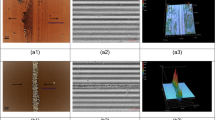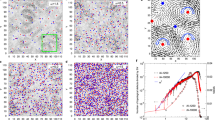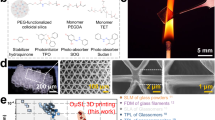Abstract
RECENTLY a short note by E. W. Taylor on plastic deformation of optical glass1 has appeared. In this connexion a photomicrograph of scratches made on an ordinary microscope slide glass by a diamond is shown in Fig. 1. The diamond was shaped in the form of a cube with its faces parallel to cube planes and one cube corner was used as the scratching point, so that a body diagonal of the cube was perpendicular to the glass slide during scratching. In this position a (110) plane of the cube is also perpendicular to the slide, and the direction of scratching lies in this plane. The scratches, as reproduced, were made with an edge of the cube leading (the other possibility being that a face is leading). The angle between the cube edge and the plane of the glass slide was about 35° (ideal value 35° 16').
Similar content being viewed by others
Article PDF
References
Taylor, E. W., Nature, 163, 323 (1949).
Ryschkewitsch, E., Indust. Diam. Rev., 6, 339 (1946).
Author information
Authors and Affiliations
Rights and permissions
About this article
Cite this article
CUSTERS, J. Plastic Deformation of Glass during Scratching. Nature 164, 627 (1949). https://doi.org/10.1038/164627a0
Issue date:
DOI: https://doi.org/10.1038/164627a0
This article is cited by
-
Damage induced by a sliding diamond ? an approach to hard rock drilling
Rock Mechanics Felsmechanik Mecanique des Roches (1972)



